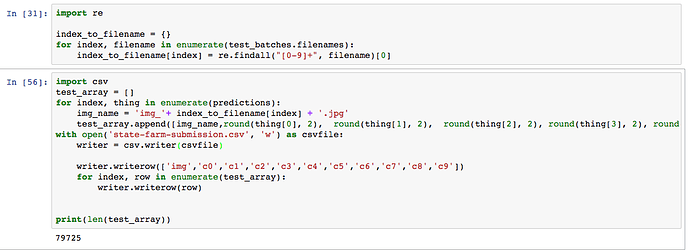Hi,
In the statefarm problem, I tried using transfer learning with the help of keras’s vgg16 model. When I shuffle the training data (set shuffle = True), the accuracy I get on training data is abysmal. When shuffle = False, I get a good training accuracy. Why does setting shuffle = True in get_batches() on the train data cause such differences in accuracy? Shouldn’t shuffle=True lead to better accuracy?
The code I have used is as follows:
import numpy as np
from keras.preprocessing import image
from keras.preprocessing.image import ImageDataGenerator
from keras.models import Sequential
from keras.layers import Dropout, Flatten, Dense
from keras.applications import VGG16
from keras.utils.np_utils import to_categorical
model = VGG16(include_top=False, weights='imagenet')
batch_size = 64
datagen = ImageDataGenerator(rescale=1. / 255)
def get_batches(dirname, gen = image.ImageDataGenerator(), shuffle=True, batch_size=batch_size):
batch_gen = gen.flow_from_directory(dirname, target_size=(224,224),
class_mode='categorical', shuffle=shuffle, batch_size=batch_size)
num_batch = len(batch_gen)
return batch_gen, num_batch
generator, num_train_batches = get_batches('./data/train', gen=datagen, shuffle=False)
train_labels = to_categorical(generator.classes)
train_data = model.predict_generator(generator, num_train_batches)
generator, num_valid_batches = get_batches('./data/valid', gen=datagen,
shuffle=False, batch_size=batch_size * 2)
validation_labels = to_categorical(generator.classes)
model = Sequential()
model.add(Flatten(input_shape=train_data.shape[1:]))
model.add(Dense(256, activation='relu'))
model.add(Dropout(0.5))
model.add(Dense(10, activation='softmax'))
model.compile(optimizer='adam',
loss='categorical_crossentropy', metrics=['accuracy'])
model.optimizer.lr = 1e-5
model.fit(train_data, train_labels,
epochs=5,
batch_size=batch_size,
validation_data=(validation_data, validation_labels), verbose=1)
When shuffle=False:-
Train on 17968 samples, validate on 4456 samples
Epoch 1/5
17968/17968 [==============================] - 4s 224us/step - loss: 1.7476 - acc: 0.4617 - val_loss: 1.4700 - val_acc: 0.6914
Epoch 2/5
17968/17968 [==============================] - 4s 197us/step - loss: 0.7867 - acc: 0.8535 - val_loss: 1.0974 - val_acc: 0.7417
Epoch 3/5
17968/17968 [==============================] - 4s 197us/step - loss: 0.4472 - acc: 0.9335 - val_loss: 0.9330 - val_acc: 0.7554
Epoch 4/5
17968/17968 [==============================] - 4s 199us/step - loss: 0.2926 - acc: 0.9613 - val_loss: 0.8638 - val_acc: 0.7655
Epoch 5/5
17968/17968 [==============================] - 4s 197us/step - loss: 0.2131 - acc: 0.9726 - val_loss: 0.8067 - val_acc: 0.7747
When shuffle=True:
Train on 17968 samples, validate on 4456 samples
Epoch 1/5
17968/17968 [==============================] - 4s 215us/step - loss: 2.3914 - acc: 0.0995 - val_loss: 2.2935 - val_acc: 0.1086
Epoch 2/5
17968/17968 [==============================] - 4s 201us/step - loss: 2.3025 - acc: 0.1113 - val_loss: 2.2982 - val_acc: 0.1241
Epoch 3/5
17968/17968 [==============================] - 4s 199us/step - loss: 2.2991 - acc: 0.1182 - val_loss: 2.2997 - val_acc: 0.0866
Epoch 4/5
17968/17968 [==============================] - 4s 203us/step - loss: 2.2961 - acc: 0.1163 - val_loss: 2.2995 - val_acc: 0.0880
Epoch 5/5
17968/17968 [==============================] - 4s 201us/step - loss: 2.2928 - acc: 0.1229 - val_loss: 2.3032 - val_acc: 0.0911



